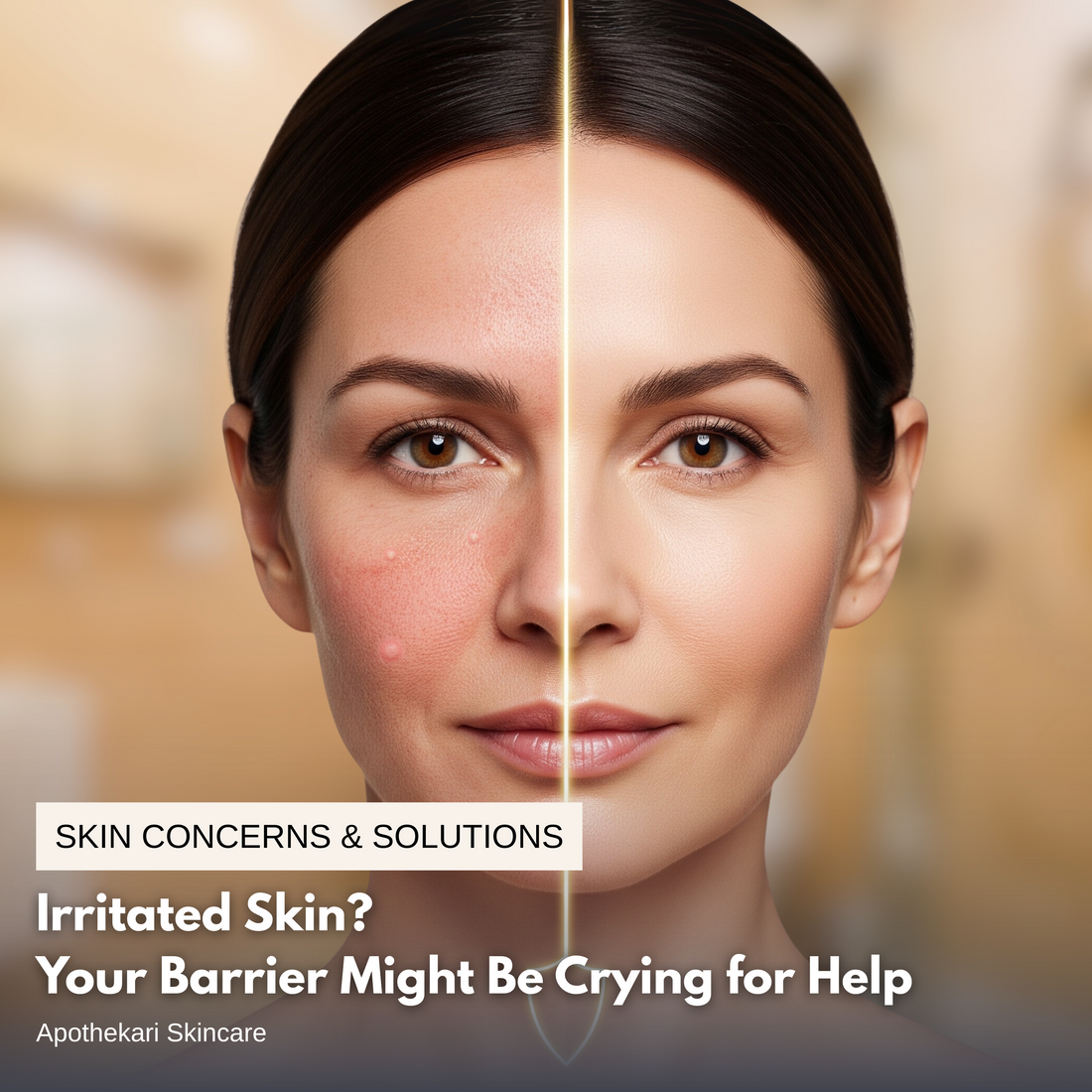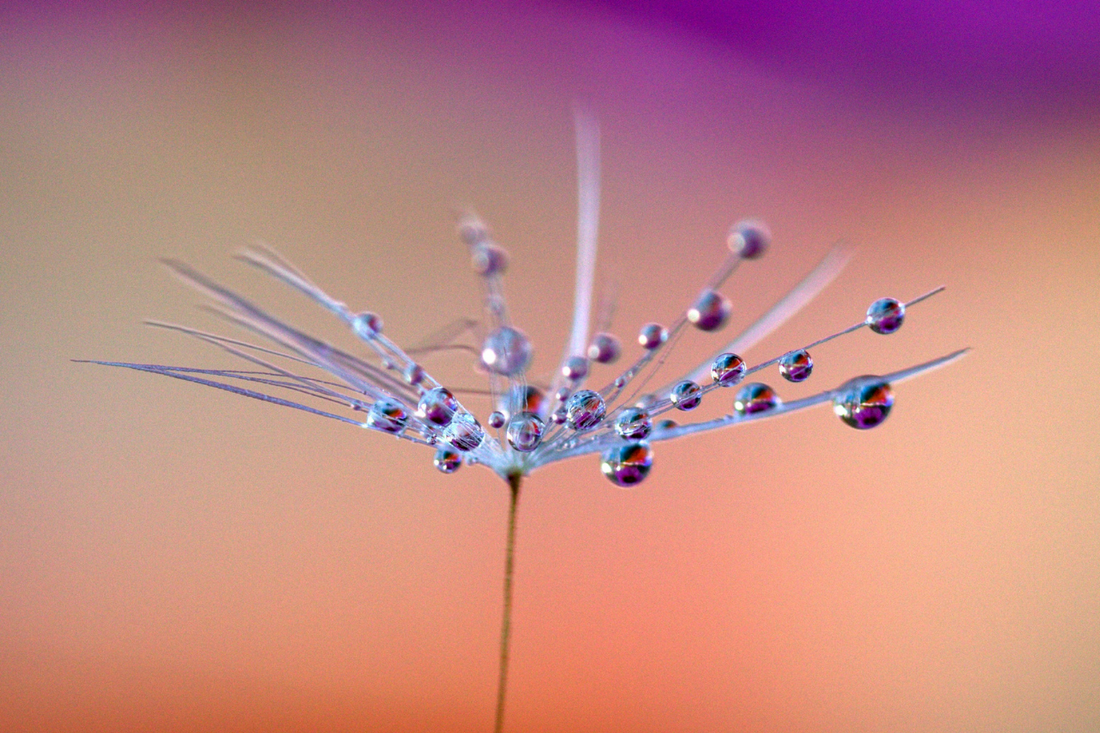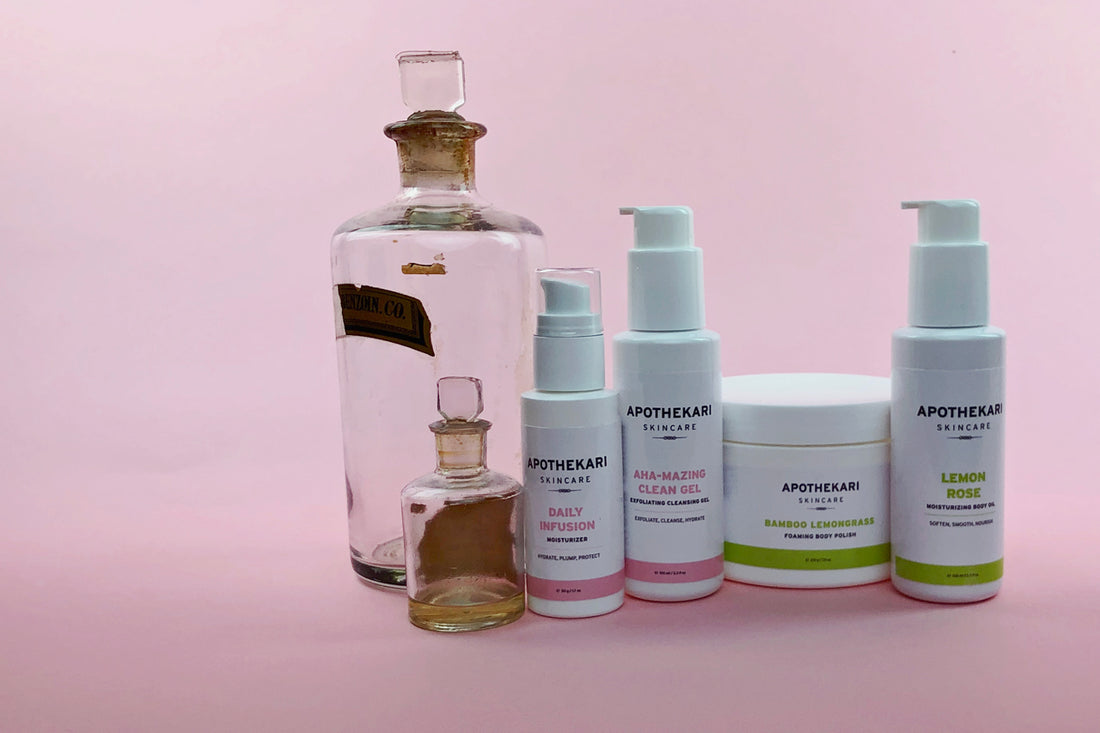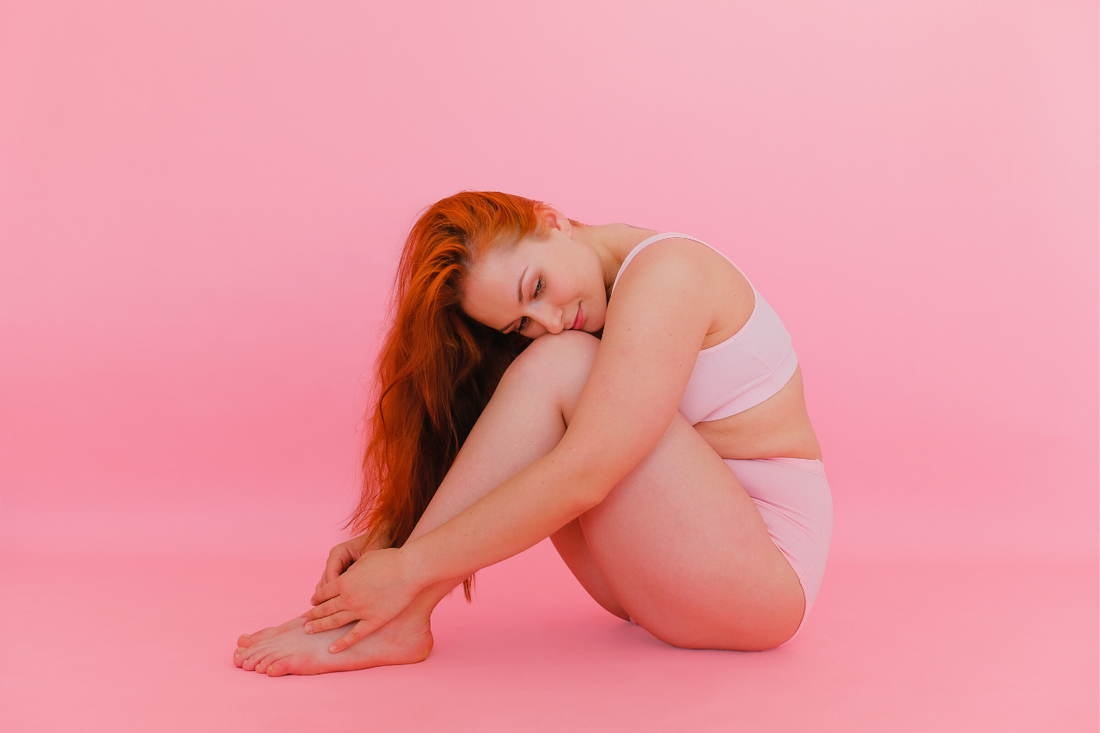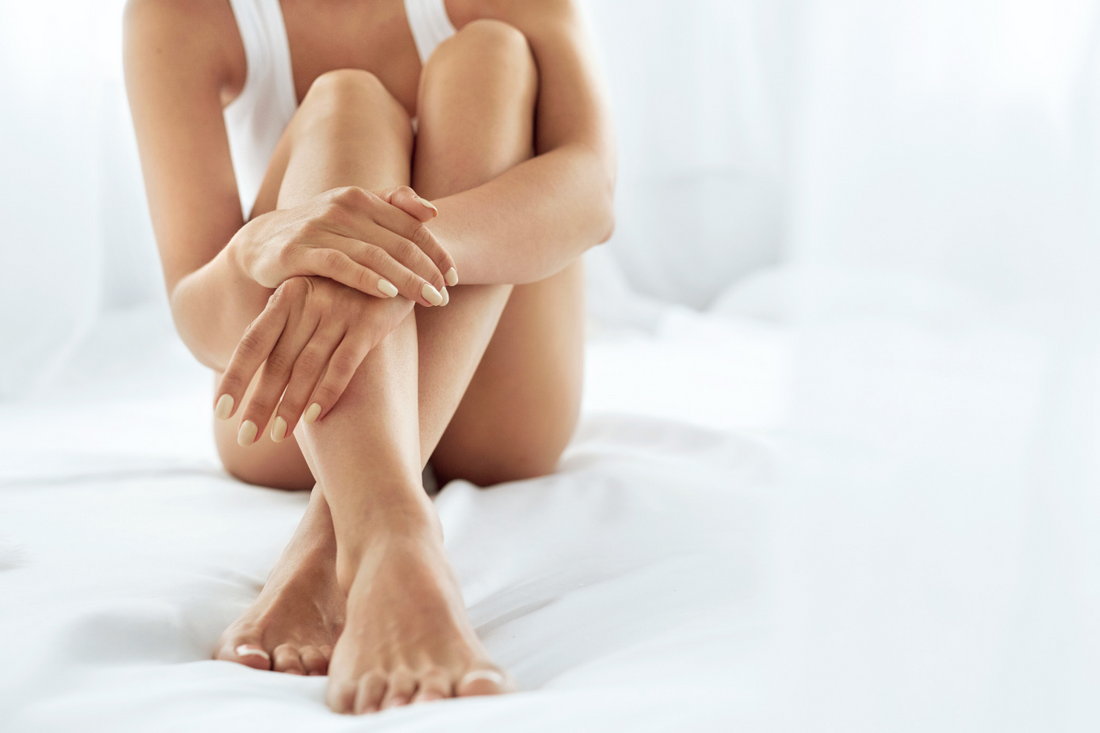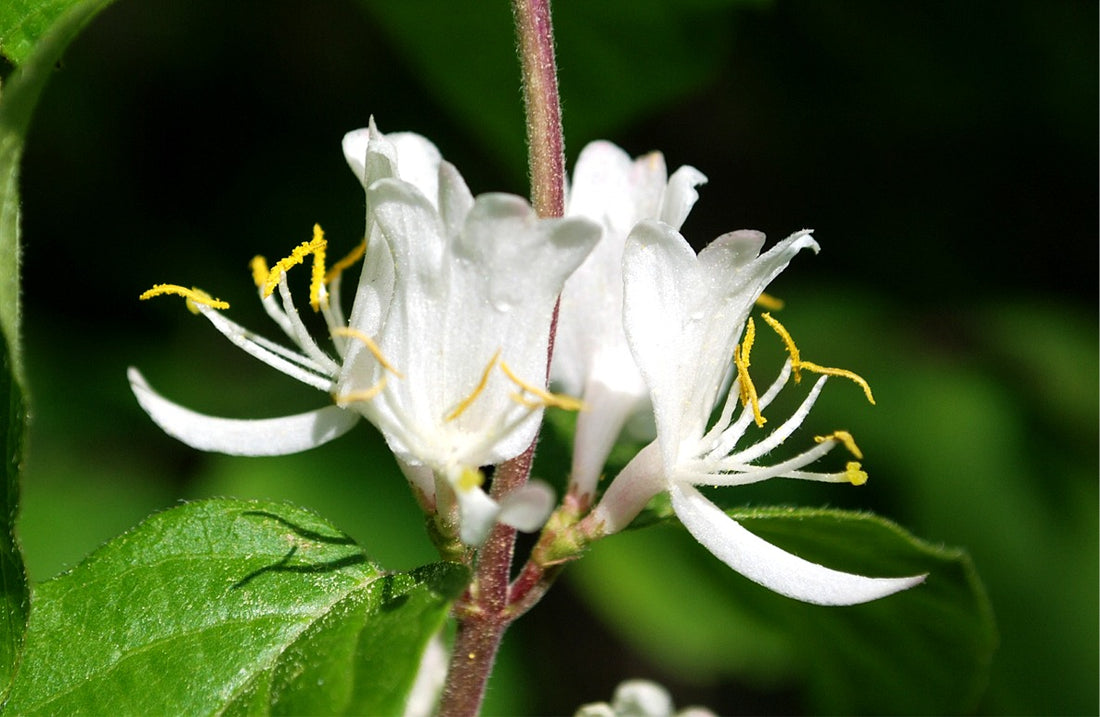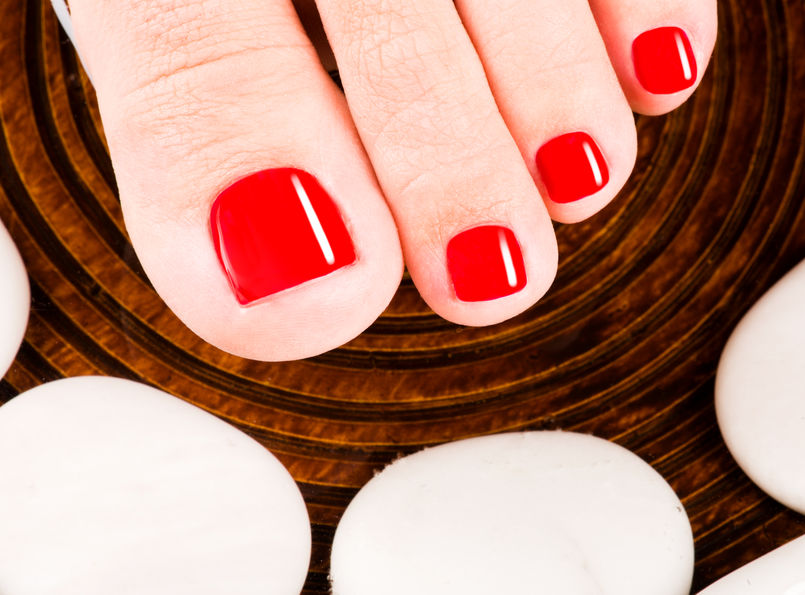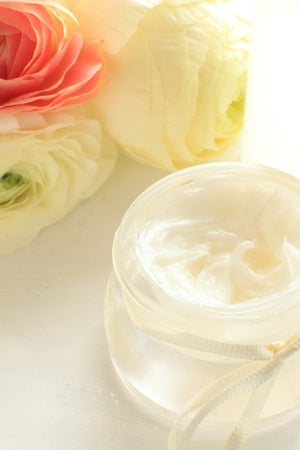Blog
Irritated Skin? Your Barrier Might Be Crying for Help
Skin suddenly acting up? Hormonal shifts can weaken your skin barrier, causing dryness, irritation, and breakouts. The fix: gentle care, deep hydration, and a simple routine to restore your glow.
Learn moreHow To Fix Menopause Dryness With These Proven Solutions
The bad news—menopause dryness is an inevitable change for women as they age. The main reason for this is due to a drop in hormone levels, primarily estrogen, which leads to some noticeable changes to your skin and hair. The good news? Menopause dryness in all your body’s places is manageable and we’ve got you covered. Read on for all the ways to help turn your skin around. More Than Lip Service is a vaginal and vulvar moisturizer that alleviates the symptoms of dryness down there that occurs in more than 50% of women. Shop Intimate Care Feminine Moisturizer Does Menopause Dryness Go Away? Sadly, the hormonal changes that occur at menopause are permanent. During the lead-up to menopause—perimenopause—and at menopause, your body makes less estrogen, the hormone responsible for maintaining the elasticity, thickness, and suppleness of your skin. And while you may notice drier skin and hair, less obvious places on your whole body, including your neck, back, and chest, to elbows, legs, genitals — even nails, may be affected too. The inside of your mouth, nose, and eyes get drier as you age, as well. You might not think of them as skin, but just like the tissues inside your genitals–they’re called “mucosa,”–hormonal changes impact these as well, leaving you with itchy eye pain, cotton mouth, and that awful sandy feeling in your vagina. Thankfully there are many ways to help you, and your skin, feel better again. What Helps with Dry Skin During Menopause We’ve written about treating dry skin before and many of the tips outlined in these posts and our free guide, can help: Here’s How to Treat Dry Skin as You Get Older Make This One Change to Relieve Dry Skin Make This One Change to Relieve Dry Skin 5 Tips to Help You Care for Your Menopause Skin And you can also download our free guide packed with 7 Powerful—and easy—Tips to Help Banish Dry Skin. Why Am I Dry Down There All of a Sudden? Beyond your skin, hair and nails, you may notice menopause dryness in some unexpected places. Like down there. Estrogen’s impact on your skin also extends to the mucosal tissue found in your vulva and vagina. Low levels of the hormone can lead to thinning, drying, and inflammation of the vaginal walls. Vaginal tissues become more easily irritated. This condition is called vaginal atrophy and can result in: Itching or stinging Burning and pain during sex or urination Light bleeding following intercourse An increased risk for developing urinary tract problems such as urinary tract infections (UTIs) and frequent urination. There are other causes of vaginal dryness as well, including breastfeeding, some medications, and certain medical conditions. Read more about this here: Don’t Put Up With Vaginal Dryness | How to Treat it How do I Treat Vaginal Dryness? Without treatment, vaginal dryness usually worsens over time. And since treatments are available, it’s important to try them to help relieve your symptoms and discomfort. There are 3 main ways to address vaginal dryness: Lubricants Vaginal/Vulvar Moisturizers Hormone Treatments What works for you depends on a number of factors, including personal choice along with trying different products. Many women may start off by using a lubricant but then move to a moisturizer like More Than Lip Service for longer term relief. Hormonal treatments are an option for some women and a discussion with your trusted medical provider is always a good place to start. Can I Use Lube to Moisturize Menopause Dryness? Lubricants are designed to deliver added moisture to your vagina just before sex or pleasuring, but their results are only temporary. Moisturizers on the other hand, deliver longer lasting benefits, keeping your vagina and/or vulva moist all day. Although they work differently and provide different results, you can use lubricants along with moisturizers if that’s what works for you. Vaginal moisturizers like More Than Lip Service are one of the best ways to reduce vaginal and vulvar dryness for the delicate tissue in this part of your body. You can use it daily to begin with, then every few days to help keep the skin and tissues moist and to relieve vaginal dryness symptoms. The moisturizer can also be applied to the vulva to relieve dryness there. Apply before bed to help it maintain contact with tissues. Don’t use moisturizers not meant specifically for this part of your body. What is the Best Vaginal Moisturizer? More Than Lip Service Vulvar and Vaginal Moisturizer offers fast, hormone-relief for when you experience dryness down there. While there are many options to choose from, research has shown that a formulation made with hyaluronic acid (as found in our More Than Lip Service Vaginal Moisturizer), helps to relieve the symptoms of vaginal atrophy, reducing dryness and itching and improving urinary incontinence, comparable to treatment with estrogen therapy. The bonus? It comes without the potential for side effects using hormonal drugs. Int J Community Based Nurs Midwifery. 2016 Jan; 4(1): 69–78. Comparison of the Hyaluronic Acid Vaginal Cream and Conjugated Estrogen Used in Treatment of Vaginal Atrophy of Menopause Women: A Randomized Controlled Clinical Trial Azam Jokar, MS,1 Tayebe Davari, MS,2 Nasrin Asadi, MD,3 Fateme Ahmadi, MD,4 and Sedighe Foruhari, MS1 Vaginal moisturizers are also available in creams, suppositories and natural oils. The key is to find one that works for you. Menopause Dryness Natural Remedies Do a search on the internet and you’ll probably find several safe and effective ways to help alleviate menopause dryness. Use caution with where you’re finding the information as not everyone who gives advice is actually qualified to give this advice. Please always consult your doctor before trying out potentially harmful treatments. That said, there are number of things you can do to help manage dryness naturally: Diet. A diet high in essential fatty acids, found in foods like fish and nuts may help to improve vaginal elasticity and tissue strength. As well, soy contains plant estrogens, which may help to reduce vaginal dryness. Last, drink plenty of water to stay hydrated. Limit caffeine and alcohol, which are dehydrating. Exercise. May help to improve blood flow and balance hormone levels. Caution with Personal Care Products. Douches, scented soaps and harsh cleansers may irritate the area and increase dryness. Have More Sex. Studies have shown that sexual intercourse helps to increase blood flow to your vagina, helping to keep tissues health. Remember to use a lubricant to help eliminate dryness and make sex more pleasurable.
Learn moreHere's How to Treat Dry Skin as You Get Older
Here’s how to treat dry skin, an inevitable skin change that comes with aging. In this post, learn about ingredients and tips that will lead to softer, smoother and more touchable skin. At Apothekari, our moisturizers are one of the best ways to manage dryness from head to toe. Shop Moisturizers Why Causes Dry Skin As You Get Older? Your skin ages in two main ways: 1. Extrinsic Aging Extrinsic aging is related to the impact of the environment on your skin. This includes exposure to the sun, pollution and smoke, plus diet and lifestyle factors. Stress, sleep, exercise all contribute to extrinsic aging. Together, they can lead to skin thickening, freckles, age spots and some precancerous changes such as actinic keratosis and skin cancers themselves. The sun’s UV rays damages collagen, elastin and other elements that lead to skin that sags, stretches, and loses its ability to snap back after stretching. Mature skin may also become drier, bruise and tear more easily, and take longer to heal. 2. Intrinsic Aging Intrinsic aging is something that we can’t fight against and which occurs as part of the natural aging process: Thinning of the dermal and epidermal skin layers, resulting in a smaller supply of nutrients to the cells A decline in the production of new skin cells and skin supportive fibers (collagen, elastin, etc) A decreased ability to retain moisture A decline in levels of the hormone, estrogen. Estrogen not only stimulates oil glands, which helps keep skin hydrated, it also helps to maintain the skin’s structure. Dryness affects the skin on all of your body. This includes your face, arms and legs, plus parts of your body, you may not have considered, like your vulva and vagina. More Than Lip Service Vulvar and Vaginal Moisturizer offers fast, hormone-relief for when you experience dryness down there. What is the Best Natural Ingredient for Dry Skin? Whether skin is mature or younger, a good moisturizer is key to help treat dry skin. Moisturizers work by either providing hydration, or by helping to prevent its loss, and they contain 3 main classes of ingredients: Humectants: Help to attract moisture to the skin. Glycerin, hyaluronic acid, urea and aloe vera are humectants. Emollients: Smooth and soften skin by helping to repair cracks in the skin barrier. They prevent moisture loss. Butters, oils, esters, lipids, and fatty acids are all considered emollients. Occlusives: Work by forming a protective coating on your skin’s surface, forming a protective barrier that locks moisture in and keeps harmful particles out. They tend to be oily or waxy. Petrolatum, lanolin, beeswax, jojoba oil, and olive oil are examples. Occlusives like oils, can also be emollients. Each class of ingredient provides benefits of its own, and they’re often combined together for the best results. For best results apply them to slightly damp skin to help lock in the moisture. What is the Best Thing for Dry Skin | Top Tips Using moisturizer is an essential step in dry skin management, but there are many lifestyle changes that you can implement to help as well: Introduce Humidity. The drier the air, the drier the skin. It’s a lesson, I re-learn every time I travel to the desert-like climate in Arizona. Consider using a humidifier in the room where you spend the most time, which, for many of us, is the bedroom. Change Up Your Diet. Increasing your intake of foods rich in omega-3 fatty acids has been shown to help improve the skin’s oil production, improve hydration and minimize the signs of aging. Look for them in nuts (walnuts are a rich source), olive oil, avocados and salmon. Watch Your Alcohol Consumption. Ah yes, a glass of red wine on a Friday evening is very appealing. We’re not telling you to give it up completely, but alcohol, along with caffeine, act as diuretics that can lead to dehydration and drier skin. Up the water intake to help counteract the effect if you can. Exfoliate. No matter how much you moisturize, dry skin will stay dry without some light exfoliation. For the face, check out our AHA-Mazing Clean Cleansing Gel and our Bespoke Vitamin C Serum, which hydrates and exfoliates as well. Cleanse Gently. Harsh cleansers can strip away skin’s protective natural oils. Choose one that is gentle—the one we’ve linked to above is gentle, yet also effective. Add In An Oil. If you’re already using a moisturizer and skin is still dry, consider adding in an oil. These help to lock in the moisture delivered by a moisturizing cream or lotion, relieving dryness even further. Our Antioxidant Face Oil is a boon to drier skin on the face while our Lemon Rose Body Oil offers luxurious hydration post shower or bath. Water—but, don’t make it hot! Hot water strips away skin’s protective oils. Switch to lukewarm and stay away from hot water when you shower, bathe or wash.
Learn moreMake This One Change to Relieve Dry Skin
Relieve dry skin on your body by making one small change this winter! Dryness is something that many of us must contend with during cooler temperatures and while most of us are fully invested in keeping our faces hydrated, our limbs need some love too. This year, consider introducing a body oil into your routine and learn why your skin will love it, in this post. Shop Lemon Rose Moisturizing Body Oil *save when buying as part of a set in our Hydrating Skin Set. What Causes Dry Skin? Dry skin isn’t usually serious, but it can be uncomfortable, often accompanied by tightness, roughness, flaking, itching or redness. Severely dry skin, however, can develop deep cracks that may bleed. Dryness increases during the winter when the temperatures are cooler and there is less moisture in the air. However, it can also occur in hotter climates with lower humidity and may be exacerbated by long soaks in hot water. You Can Help Manage Dry Skin With: Quick showers in lukewarm (not hot) water Mild cleansers Humidifiers to increase moisture in the air Moisturizers including creams, lotions and oils Hydrating Skin Set – Contains Body Oil & Face Oil Body Oils Soften Skin Better You may be used to using a body lotion, but body oils soften skin better. That’s because oils mimic the natural lipids found in our bodies, sinking in between skin cells, leading to a better, smoother skin surface, which helps to soften roughness. Oils also are more protective than lotions and much better at locking in moisture. These qualities make them especially beneficial for super-dry skin or eczema. If you’ve never used a body oil before, you’re in for an experience! Body oils can transform the humdrum chore of moisturizing into something quite luxurious, making you feel as if you’re in a gorgeous spa somewhere (the Italian countryside?) instead of your boring bathroom. Scented body oils, like ours, just up the pleasure factor. How To Use A Body Oil Body oils absorb best when skin is warm and slightly damp, after towel drying. Applied this way, they can also help to lock moisture. They’re not restricted to bath time use only; use a body oil any time of the day to nourish and pamper skin. We like adding a small amount to our body lotion or cream to amp up the hydration. Beyond their amazing moisturizing qualities for dry skin, try using a body oil as a bath oil or a hair oil. They also work wonders to soften cuticles on your nails. Have we converted you yet?
Learn moreCelebrate Softer Skin With This Set!
Celebrate softer skin! Whisk away dryness leaving silky, smooth skin with these exfoliating and moisturizing face and body products. Shop All Apothekari What Makes Skin Feel Rough & Dry? Softer skin is something we all desire, yet many of us experience skin that is rough, dry and sometimes painful. Dry skin can occur anywhere on the body, but certain areas are more likely to become very dry or even rough and cracked. Dryness tends to occur gradually, starting to feel tight and somewhat rough but then progressing to increased tightness, roughness, cracking and itching. Skin may also start to flake. When the dryness penetrates into the deeper layers of skin, skin starts to feel very rough. Frequent washing, extreme temperatures, dry air and hot baths can contribute to dryness. Our genes, age and hormone levels also play a role. What we eat along with medications we take may also lead to dry skin. Exfoliate & Moisturize for Softer Skin Having soft skin requires minimizing exposure to factors that contribute to rough, dry skin: Avoid dry air by spending less time outdoors in hot and cold weather, and by using a humidifier indoors when the heating is on Reduce the time spent in hot water by having quick showers instead of long baths Use gloves when washing dishes to minimize contact with hot water and strong detergents. Your skincare routine plays a role – stick to gentle products, especially avoiding harsh, stripping cleansers. It’s important, as well, to exfoliate and then moisturize. Exfoliation helps to remove the dead, dry skin cells that sit on the skin’s surface causing it to look and feel rough and which can slow down the absorption of products you put on top. Moisturizing helps to deliver hydration to skin, locking in moisture. Our Soft Skin Set includes four products that both exfoliate and moisturize to deliver soft, silky skin on your face and body: Daily Infusion Moisturizer. Hydrate, plump and protect facial skin with this light, non-greasy formulation that is suitable for all skin types AHA-Mazing Clean Cleansing Gel. Cleanse and soothe skin; prep it for other products with this gentle exfoliating cleanser Lemon Rose Moisturizing Body Oil. Instantly transform dry body skin into soft, supple skin with this ultra-moisturizing and rich body oil Bamboo Lemongrass Foaming Body Polish. Punch up the smoothness and pamper your skin with an invigorating exfoliating body polish. Who’s ready for softer skin this winter?
Learn moreA Body Oil For Instantly Soft Skin
Now that the cold season is officially here, instantly transform dry skin on your body with our new Lemon Rose Moisturizing Body Oil. Just a bit of TLC with this ultra-moisturizing and rich formula, helps deliver soft, supple and touchable skin. Shop Lemon Rose Moisturizing Body Oil Nourish Dry Skin Apothekari’s Lemon Rose Moisturizing Body Oil is an excellent source of nutrients and moisture for dry, irritated and chapped skin. Protect and nourish your body with a rich combination of precious oils: Jojoba Seed Oil. Jojoba oil is very similar to human skin oils allowing for easy absorption to deeply hydrate, sooth, soften and moisturize. It is anti-inflammatory and contains, vitamins, antioxidants and minerals to help nourish and protect skin. Rosehip Seed Extract. Rich in fatty acids, rosehip seed extract is useful in providing relief to chapped and irritated skin. It’s a rich source of antioxidants, helping to protect skin. Kukui Nut Oil. Easily absorbed, Indonesian kukui nut oil has a high fatty acid content along with tocopherol (Vitamin E). Deeply moisturizing and anti-inflammatory. Shea Nut Butter. A source of vitamins and anti-inflammatory compounds, this emollient ingredient relieves dryness and aids with the symptoms of eczema and psoriasis. Raspberry Seed Oil. High concentration of fatty acids to supports skin cell membrane function, helping to retain moisture and maintaining skin elasticity. Essential Oil Blend. Pamper skin with this intoxicating blend featuring rose, lemon and jasmine. All this in our base of sunflower seed oil plus vitamin E delivers additional antioxidant and anti-inflammatory benefits and helps to trap moisture on skin, keeping it hydrated longer. How to Use a Body Oil When it comes to moisturizing, skin needs both oil and water/water-loving ingredients (like glycerin, hyaluronic acid, propanediol) to stay healthy. Oil alone is not enough to hydrate skin, which is why a body oil should be applied directly after a bath or shower while skin is still damp. Enjoy using a body oil as part of your self care, massaging onto skin using gentle strokes. This helps to lock in the moisture and keeps skin feeling soft and smooth all day long.
Learn moreThe Essentials For Smooth Skin On Your Body
If summer living has left you with arms and legs that are dry, rough and/or cracked, learn about the essentials necessary for touchable and smooth skin! *Our Bamboo Lemongrass Body Polish has been discontinued, but consider our Shea Body Butter or Lemon Rose Moisturizing Oil to help keep skin soft and smooth. Shop Lemon Rose Moisturizing Body Oil We’re summer’s biggest fans at Apothekari, but extended sun exposure can do a number on your skin. Unprotected exposure to UVA rays can destroy collagen and elastin, which helps give skin a smooth and resilient texture. Plus, it can make it look and feel drier and rougher. While sun protection is important, it’s also necessary to use products that can help to undo the damage that summer can cause. Learn what they are in this post. What Causes Rough Skin? Your skin’s texture and appearance are affected primarily by its uppermost layer, the stratum corneum, which is made up of dead skin cells along with a mixture of ceramides, cholesterol and fatty acids. These substances help to keep moisture in and irritants out. A build-up of these dead skin cells along with a lack of moisture and hydration are the main reasons that skin appears rough and dry. Low humidity or skin conditions such as eczema, psoriasis or keratotis pilaris, may worsen your skin’s appearance. Plus, the hormonal changes associated with perimenopause and menopause may also detract from smooth skin. If you’re after smooth skin, it’s essential to do these 2 things: Exfoliate Moisturize The two products found in our Smooth Skin Body Set can help. Exfoliate for Smooth Skin Gentle cleansing and mild exfoliation help to deliver radiant and smooth skin by removing the dead skin cells on the surface that leave skin looking and feeling rough, dull and dry. Exfoliate either chemically (as with ingredients known as alpha hydroxy acids – AHAs – acids which help to dissolve the ‘glue’ that holds skin cells together) or mechanically by using scrubs and polishes. Many of us pay attention to our facial skin, but we often overlook our hands and feet – parts of our body that suffer the most wear and tear, especially during the warmer months. Our Bamboo Lemongrass Foaming Body Polish is formulated with walnut shell powder, powdered bamboo and a gentle cleanser to whisk away dead, dry skin cells leaving smooth skin behind. It’s invigorating and refreshing essential oil scent turns a shower or bath into a spa-like event. Moisturizers Lead to Smoother Skin Once you’ve removed the dead skin leading to roughness, it’s important to moisturize. A good moisturizer helps to prevent flaking and dry patches by replenishing and locking in moisture. Whether you opt for a lotion, a cream or a butter, moisturizers help to deliver soft and smooth skin by plumping up skin cells. For best results, apply moisturizers to damp skin as quickly as you can after stepping out of the shower, to trap water and seal it in. Our Shea Body Butter contains healing herbs, fresh oils, natural vegetarian waxes in an organic shea butter base to heal dry, cracked and callused skin. We’ve combined both the Bamboo Lemongrass Foaming Body Polish and the Shea Body Butter into our Smooth Skin Set so that your skin can benefit from both exfoliation and moisturization on a regular basis. Beauty From Within: Smooth Skin With These 3 Tips Here are 3 additional things you can do every day to ensure smooth skin: Drink Water. (Caution with the caffeinated, sugary beverages or alcoholic drinks) to help hydrate and assist your body’s metabolic processes. Fruits and vegetables count as well – not only are many high in water content (melons, cucumbers, etc), but they are also filled with micronutrients that help to maintain healthy skin. Get Enough Beauty Sleep. A lack of quality sleep increases your body’s production of cortisol, a stress hormone that can increase the inflammatory response in skin and showing up as more acne or skin sensitivity along with psoriasis and eczema. Exercise. Increases blood flow to the blood vessels, helping to provide more micronutrients to skin and enhancing its appearance.
Learn more5 Questions to Ask Before You Choose a Moisturizer
If you’re wondering how to choose a moisturizer that’s right for you, you’re not alone. Moisturizers seem to be the number one requested product when we feel that something is wrong with our skin and in an earlier post I questioned whether or not you even need one. If you do, there are 5 questions to ask before you choose a moisturizer. Shop Daily Infusion Moisturizer What is a Moisturizer? Moisturizer is a broad term used to describe products that we use to make our skin feel more comfortable and lubricated (not dry). They range from very light products like serums and lotions to heavier and more occlusive ones like petroleum jelly. Water itself can moisturize skin but it evaporates very quickly. On the other end of the spectrum, petroleum jelly also moisturizes, but it is sticky and greasy unpleasant to use on a regular basis. An ideal moisturizer for most of us falls somewhere in between the two, containing some water with a heavier, occlusive substance to help lock it all in. Moisturizers are made up of 3 main types ingredients: Humectants. Attract water to the skin by grabbing it from the environment. Can also pull water from deep in the skin (dermis) to the surface layers (epidermis). Examples include honey, propylene glycol, propanediol, hyaluronic acid (sodium hyaluronate), glycerin, ethylene glycol. Emollients. Help to fill in the gaps in skin leaving it feeling softer and smoother. They may also help to lock in moisture. Includes lipids (fats) and oils such as jojoba oil, castor oil, vitamin E and cholesterol and some silicones as well. Emollients may also work as occlusives. Occlusives. Help to lock in water by forming a thin, oily layer over the skin. They work best when applied to damp skin. Examples include petroleum jelly, lanolin, mineral oil, silicones, beeswax, cholesterol and fatty alcohols including cetyl alcohol and stearyl alcohol. Many occlusives are also emollients. We’re big fans of Apothekari Daily Infusion Moisturizer , which contains a good balance of humectants (glycerin), emollients (caprylic/capric triglyceride, coco-caprylate/caprate, squalane) and occlusives (cetearyl alcohol, cetearyl glucoside, glyceryl stearate) and which is suitable for all skin types. How To Choose a Moisturizer Your choice of moisturizer depends on your skin type and the time of year. You may not require a moisturizer during the summer months, when traveling to tropical locations or when the humidity is high. However, when you travel away from home, the weather changes and/or the humidity drops, you may need to reassess your routine. Skin changes due to a number of factors so a routine that always used to work for you may need to be revisited every now and again. Here are 5 questions to ask before you choose a moisturizer that is best for your skin. What is Your Skin Type? Dry skin requires a moisturizer with more emollients and occlusive ingredients to help block water evaporation. Oily skin often does well with water-based products containing a lot of humectants (like a hyaluronic acid serum) or may be able to forgo a moisturizer altogether. Is Your Skin Dry or Dehydrated? Dry skin is skin that is lacking in oils while dehydrated skin is skin that it is lacking in water. Dry skin feels rough and appears dry and flaky. Dehydrated skin looks dull and feels tight and rough. It may show fine lines, sagging and wrinkles. Both oily and dry skin can be dehydrated, meaning that it is lacking in water or moisture. Dehydrated skin benefits from humectants to help hydrate and plump. Ingredients including glycerin, sodium hyaluronate and propanediol work well. What Time of Year is it? If temperatures have dropped and the air is drier (like now) or if you’ve traveled somewhere where that’s the case, you may need to introduce a moisturizer if you aren’t currently using one. Or, you may need to switch to one that contains more emollient and occlusive ingredients. Conversely, if it’s getting warmer and there’s more moisture in the air, you may need to swap out your heavier moisturizer for one that is lighter (more humectants and fewer emollient or occlusives). If you’re spending more time outdoors, consider that the sun’s UVA rays can lead to dehydrated skin so ensure that you are wearing a sunscreen and consider upping the moisturizer. Has Your Skin Experienced Age Related Changes? Our skin may become oilier as we enter adolescence. As we approach our twenties, it becomes drier. The hormonal changes that women experience as they age can lead to further dryness so it’s important to acknowledge that you may require a different moisturizer as you get older. What Type of Moisturizer Do You Like? Sometimes finding the right product can take a bit of trial and error. If you’re not happy with how your moisturizer feels on your skin, it may not be a good match. Shop around and test products until you find one that you enjoy using. Once you’ve found a moisturizer that works for you, keep the following in mind: Apply over damp skin to lock in moisture. Moisturize as often as you need to. Use SPF daily to help combat dryness and skin damage. Did this post help you with how to choose a moisturizer?
Learn moreOld Lady Feet: And How to Fight Back
Is it just me or is it every woman of a certain age that eventually has to deal with ‘old lady feet’? Hard to define precisely, the topic of old lady feet crops up more frequently at social gatherings where women congregate these days. It becomes particularly more commonplace during warmer weather, when most of us tend to be more conscious of our exposed feet. My feet don’t look that old, but they often really feel it so I guess the term old lady feet applies. While I’ve never really embraced high heels, there was a time that I could put them on and KEEP them on for an entire evening, often even dancing the night away. Now, just the thought of putting on shoes sporting heels higher than 2 ½ inches is enough to make me cringe. These days, comfort trumps all. If you’re one of those women feeling sorry for the lost feet of youth, don’t despair. Our bodies change as we age and feet aren’t immune to this impact. Here are 5 things that happen to our feet as we get older along with some tips to ease the pain: 1. Fat Disappears We’re born with built-in insoles – collagen and elastin, stuffed with fat tissue on the bottoms of our feet. But collagen decreases as we age, thinning out the fat pads and decreasing the cushioning effect. Your feet may be fine in the morning, but can become quite painful at the end of the day. Solution: Before considering fat transplants (expensive and little proof they work), seek out cushioned and comfortable shoes. Wear insoles or gel pads if you need to. Have you noticed how many women have embraced the sneaker look; the rise of the Birkenstock? Coincidence? I think not. 2. Arthritis Develops Our bones and joints can degenerate with age causing pain and morning stiffness. The big toe or the joints on the top of your foot are most likely to be affected. Solution: Try shoe inserts, exercises or losing weight to see if that helps. Seek medical attention if the pain persists. 3. Skin Dries Out The collagen which cushions your feet, also plumps up your skin. A decline in collagen can leave the soles prone to dryness and cracking. Solution: Take care by applying a hydrating foot or body cream. We love Apothekari Shea Body Butter applied after the bath or shower and again when you go to bed. Wearing socks over top of your moisturizing treatment while you sleep can work wonders. 4. Tendons & Ligaments Turn Against You As you age, your body’s ability to hang on to water declines and you can witness this in your tendons, causing stiff ankles and other body parts. On the flip side, other connective tissues called ligaments may stretch out over time, leaving you with fallen arches and a flatter foot. You may not be as well balanced either, leaving you prone to ankle sprains. Solution: Exercise is your best friend here. Try strengthening exercises like ankle circles and toe raises. Calf raises can help to relieve tight ankles. 5. Bunions, Corns and Hammertoes Improperly fitting shoes, anatomical and hormonal changes and genetics may all play a role in the development of these foot complications. Although not medially serious, they may make you feel self-conscious about your feet. Solution: Check in with your doctor or a podiatrist to see if they can help. If you feel a lot of pain, surgery may be recommended. Don’t let old lady feet get you down. A new generation of women now who want fashionable AND comfortable shoes and shoe makers are starting to take notice. Shoes that are functional, supportive AND fashionable are easy to find these days. Sporting low, sturdy heels, cushioned foot beds and rubber soles, this footwear has style to boot. Splash out on a pedicure and go shoe shopping. Here are a few pairs that have caught my eye recently: Clarks Amali Tulip Leather Shoe in Silver Coclico Pop-Up Wedge Stuart Weitzman Nudist June Sandal. Isn’t the pink just divine? Eileen Fisher Black Leather Blog Slide
Learn moreStress and Skin: 5 Signs to Watch
Stress and skin; is this something you’re concerned about? If you follow us on social media, you may note that we often post about relaxation, zen, work/life balance and looking after yourself. It’s a well-known fact that stress affects your overall health, including that of your skin. Wellness is something that I feel deeply about so it’s a topic that won’t be a stranger to this blog. Shop A Is for Anti-Aging Serum (Our Retinoid Formulation) Shop Bespoke Vitamin C 15% In today’s post, we’ll look at the connection between stress and skin along with 5 signs to watch out for. First, it’s important to acknowledge that stress isn’t always bad. There is good stress and then there is bad stress. Good stress happens when we are busy doing things we love – planning a big event – a holiday, a party or a wedding. Good stress may also be found in the workplace, when we win a big project, receive a promotion and throw ourselves into our jobs. This kind of stress helps keep us happy, engaged and excited with life. However, when work takes over and we can’t come up for air, we find ourselves struggling about how to pay the bills or if you or someone you care about are faced with a serious illness, bad stress can step in. What Does Stress Do To The Body? When we’re under stress, our body copes by releasing a number of hormones, including cortisol. In short bursts, cortisol helps us cope with stressful situations, which is fine if levels are elevated temporarily. Continue the stress long term, however, and high cortisol levels start impacting our health in a number of ways, lowering our immune function, increasing weight gain, increasing the potential for depression and interfering with our memory. When it comes to stress and skin, here are 5 signs that should encourage you to pay attention: 5 Skin Signs of Stress 1. Dryness/Dullness Cortisol can damage the skin’s ability to hold on to water, resulting in moisture loss. Skin may appear dull. Avoid hot water and fragrances and seek out hypoallergenic products to help prevent further dryness. 2. Itchy, Ugly Rashes The loss of moisture explained above can also damage the skin’s natural barrier which is in place to keep out bacteria and other harmful substances. When this protective layer is damaged, harmful bacteria may penetrate through to the deeper layers of skin. These bacteria produce a protein that may activate the immune system, leading to eczema and psoriasis. Additionally, cortisol acts as a powerful steroid that shuts down one part of the immune system (making you more susceptible to colds and flu) but cranks up another, making you more susceptible to allergens, which can lead to itchy and inflamed skin. 3. Cold Sores The impact of stress on the immune system not only increases the risk for flare-ups of cold sores but also shingles, and viral warts. 4. Fine Lines Cortisol. Again! This time, it adds to fine lines by triggering elevated blood sugar levels via a process known as glycation. Ultimately, glycation damages collagen and elastin, two fibers that help to keep skin smooth, plump and firm. Retinoid treatments as in Apothekari A is for Anti-Aging Serum along with antioxidants (try Apothekari Bespoke Vitamin C Serum) stimulate collagen production and can help to diminish the appearance of wrinkles and fine lines over time. 5. Acne Stress triggers the release of androgens (male hormones) like testosterone which are responsible for the production of sebum. The resulting blocked pores provide a perfect breeding ground for acne. Try incorporating treatments with salicylic acid or retinoids, which help to control bacteria and clogged pores. Living a full life inevitably comes with stress. The key is in how you manage it. What’s your strategy?
Learn moreDo You Need a Moisturizer? Maybe Not
Do you need a moisturizer? You may or you may not and usually, your skin will let you know. Since many of us have grown up with a ritual that involves cleansing, toning and moisturizing, it probably shouldn’t come as a surprise that this is what women think they need to keep their skin looking its very best. I always assume that skin dryness is the issue that people are trying to fix with a moisturizer, but I’m never quite sure. Is your skin dry, dehydrated, flaking, red, sore? Any of these symptoms may have you reaching for the moisturizer but a moisturizer may not be what you need! ‘Moisturizers’ comprising animal fats and plants have been used since very early times by indigenous people of Africa, South America and North America to hydrate and protect skin against hot weather and the sun. Today’s versions are a mixture of naturally occurring skin lipids, oils, humectants and emollients, which are designed to make the skin’s outermost layer – the epidermis – feel softer and suppler. They also hydrate skin by reducing water loss. Shop Moisturizers Moisturizers can be an integral part of a skin care regimen, but they certainly shouldn’t be considered as the only or the most important part of any routine. So do you need a moisturizer? Here’s what you may need instead: 1. Dry or Dehydrated Skin? Yes, a moisturizer may be helpful here. By sealing in moisture (after washing or bathing), a moisturizer can deliver emolliating ingredients and prevent further moisture loss. Avoid products containing alcohol, which can contribute to further dryness. If you have oily skin which is dry from over-treatment with harsh, abrasive and/or drying topicals, lighter hydration, in the form of a serum may be a better option. A rich and heavy cream can clog pores leaving you in the same situation you started off in. 2. Flaking Skin? If your skin is flaking, do you need a moisturizer? In this case, you most likely need to exfoliate and not moisturize. Our skin cells turn over with new skin cells once about every 28 days and this process slows as we age. A build up of dead skin cells can leave skin looking old, dull and dry with flakiness. Exfoliation helps to remove this top layer of dead skin cells revealing the newer and healthier ones below. If you exfoliate, you may not require moisturizer as often or as much. Many good exfoliating agents, including alpha hydroxy acids (AHAs) are available. As an added bonus, any of the other skin care treatments you apply, including a moisturizer, will be absorbed much better. You may think this counterintuitive, but in the case of flaking skin, retinoids (such as retinol, retinaldehyde and retinoic acid) may be your best friend. Retinoids promote faster skin cell turnover and encourage collagen production. Newer skin cells are healthier skin cells, which will displace the older, unhealthier ones sitting at the top of your face. There’s a method to the madness of using retinoids with dry skin! Find gentle retinaldehyde in A is for Anti-Aging Retinal Serum. 3. Dull Skin Like flaking skin, dull skin benefits from exfoliation. Old skin cells resting on top of newer ones, lead to dull, lifeless and aged looking skin. These old skin cells may not be flaking yet, but left unchecked, they soon will be. Follow the tips above (including the use of retinoids) and skin will appear refreshed and younger looking. You may want to consider adding in a treatment containing Vitamin C, which helps to even out and brighten skin tone. As an added bonus, Vitamin C possesses antioxidant activity, which will help to protect skin against environmental damage. It also boosts collagen production and helps skin feel firmer. Vitamin C as L-ascorbic acid is in Bespoke Vitamin C Serum 10% or 15%. 4. Red Skin Redness is an indication of inflamed skin. It is also associated with rosacea, a condition experts believe is due to a combination of genetic and environmental factors. The top causes of skin irritation are unprotected sun exposure and other environmental factors including pollution and low humidity. Topical products with sensitizing ingredients including fragrances and essential oils may be problematic. Harsh scrubs and hot water may also be to blame. You may be allergic to something in your diet or environment. If this is the case, it’s important to identify it in and remove it in order to allow your skin to improve. Working with a good allergist or dermatologist can be very helpful in this case. Do you need a moisturizer for red skin? Red skin benefits from soothing products – whether they are moisturizers, serums, creams or lotions. Ensure that they are free from fragrances, alcohol and other harsh ingredients. The daily use of a well formulated sunscreen can help to protect against the sun and environment. Look for ingredients including aloe, bisabolol, oat extract, licorice, antioxidants (vitamin c, resveratrol, curcurmin) and zinc oxide to calm. 5. Sore Skin Much like red skin, skin that is sore suffers from irritation and often, inflammation. The advice to handling sore skin is similar to that offered for red skin. Identify and remove allergens, use good sun protection and avoid harsh ingredients and treatments. Anti-inflammatories and skin soothing ingredients as above, are your best friend. Both red skin benefit from gentle treatments like Daily Infusion Moisturizer and Cloud Nine Foaming Cleansing Crème, suitable for individuals with sensitive skin. So, “Do you need a moisturizer?” Maybe. But before automatically reaching for one, consider if you really need one. And the next time you ask me, don’t be surprised if I recommend something entirely different instead!
Learn more

